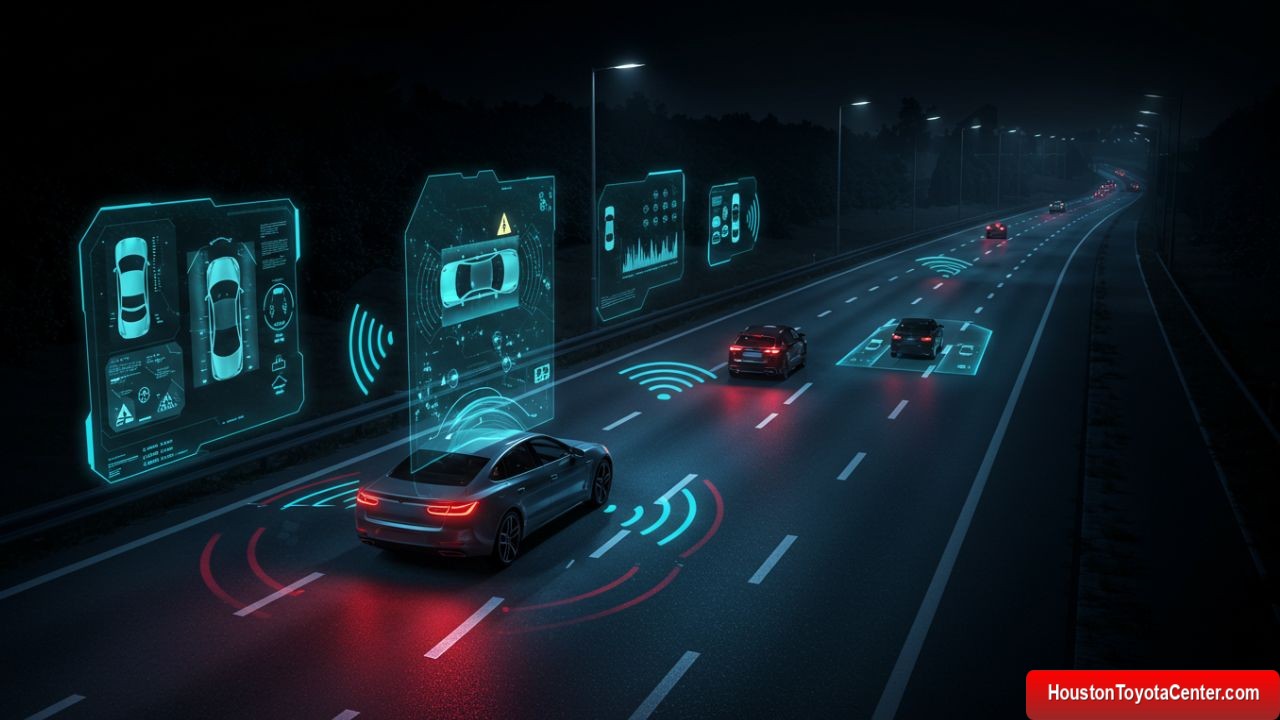Car accidents are among the leading causes of injury and fatalities worldwide. For decades, automakers focused on passive safety features—things like seatbelts, airbags, and crumple zones—to minimize injury when an accident occurs. But today, the focus has shifted dramatically toward preventing accidents before they happen.
Modern vehicles now come equipped with a suite of advanced driver-assistance systems (ADAS) that use cameras, radar, sonar, and even lidar to monitor the driving environment. Four of the most critical technologies in this safety revolution are:
- AEB (Automatic Emergency Braking)
- FCW (Forward Collision Warning)
- LDW (Lane Departure Warning)
- BSM (Blind Spot Monitoring)
These systems don’t replace the driver—they support and enhance driver awareness, acting as a digital co-pilot that can help reduce human error, which accounts for more than 90% of traffic accidents.
In this article, we’ll dive deep into each of these technologies, exploring how they work, their benefits, and their impact on reducing accidents.
FREE: Quickly identify and understand problems with your vehicle 🚘
CLICK HEREThe Rise of Preventive Safety in Cars
In the past, most safety innovations were reactive. If you crashed, your car was designed to protect you as much as possible. But this mindset has shifted.
Now, automakers are focused on “Vision Zero”—the idea that fatalities and serious injuries in road traffic can eventually be eliminated. Technologies like AEB, FCW, LDW, and BSM are vital steps toward this ambitious goal.
This shift is powered by:
- Artificial Intelligence analyzing real-time driving data.
- Radar and cameras continuously scanning the road.
- Machine learning models predicting potential hazards.
These tools are designed not just to react, but to predict and prevent accidents before they occur.
Automatic Emergency Braking (AEB)
Definition: AEB is a system that automatically applies the brakes if it detects an imminent collision and the driver does not respond in time.
How It Works
- Uses radar, cameras, or lidar to detect vehicles, pedestrians, or obstacles.
- Issues a warning to the driver if a crash is likely.
- If the driver fails to brake, the system automatically applies the brakes to mitigate or avoid the collision.
Benefits of AEB
- Reduces rear-end collisions by up to 50% in some studies.
- Can prevent pedestrian accidents, especially in urban environments.
- Acts as a safeguard against distracted driving.
Example in Real Life
Imagine you’re approaching stopped traffic while distracted by adjusting your navigation. AEB senses the stopped cars, warns you, and then automatically applies the brakes to prevent a crash.
Forward Collision Warning (FCW)
Definition: FCW alerts the driver if they are approaching another vehicle too quickly and a collision is imminent.
How It Works
- Relies on radar and camera sensors.
- Continuously monitors the distance and relative speed between your car and the one in front.
- Issues audible, visual, or tactile alerts (like steering wheel vibration) to warn the driver.
Benefits of FCW
- Gives drivers extra time to react.
- Prevents rear-end collisions caused by distraction or drowsiness.
- Reduces insurance claims related to fender benders.
Example in Real Life
On a highway, traffic suddenly slows down. Your FCW system beeps loudly, allowing you to brake in time to avoid rear-ending the car ahead.
Lane Departure Warning (LDW)
Definition: LDW alerts the driver if the car unintentionally drifts out of its lane without signaling.
How It Works
- Uses cameras to monitor lane markings.
- Detects when the vehicle drifts left or right without a turn signal.
- Issues a warning—such as steering wheel vibration or dashboard alert.
Benefits of LDW
- Reduces crashes caused by fatigue or inattention.
- Helps prevent side-swipe collisions.
- Particularly useful on highways during long drives.
Example in Real Life
You’re on a late-night road trip, and your eyes start to feel heavy. LDW senses your car drifting across the lane line and alerts you, helping you refocus before a dangerous situation develops.
Blind Spot Monitoring (BSM)
Definition: BSM warns drivers when another vehicle is in their blind spot, typically during lane changes.
How It Works
- Uses radar sensors placed on the rear sides of the car.
- Monitors traffic in adjacent lanes.
- Illuminates a small icon in the side mirror or gives an audible alert if you signal to change lanes while a car is present.
Benefits of BSM
- Prevents collisions during lane changes.
- Enhances confidence in heavy traffic.
- Especially useful in larger vehicles like SUVs and trucks.
Example in Real Life
You’re about to merge onto the highway. BSM lights up in your mirror, alerting you to a fast-approaching vehicle you hadn’t noticed. You wait, avoiding a potential side-impact crash.
Comparison of Modern Safety Tech
Here’s a quick breakdown of how these systems complement each other:
| Feature | Primary Function | Prevents | Works Best In | Driver Interaction |
|---|---|---|---|---|
| AEB | Automatically brakes to avoid collision | Rear-end & pedestrian crashes | City & highway | Automatic action |
| FCW | Warns of imminent frontal collisions | Rear-end crashes | Highway driving | Driver must react |
| LDW | Alerts if drifting out of lane | Side-swipe & run-off-road | Long-distance & night driving | Driver must correct |
| BSM | Warns of vehicles in blind spot | Lane-change crashes | City & highway | Driver must adjust |
The Synergy of These Technologies
Each of these systems is powerful on its own, but their real strength lies in how they work together:
- AEB + FCW: One warns, the other acts if the driver doesn’t.
- LDW + BSM: Together, they protect from side collisions and drifting accidents.
- All Four Combined: Create a 360° safety net that enhances driver awareness and intervention.
With more vehicles adopting ADAS suites (Advanced Driver Assistance Systems), accident prevention is no longer just about individual skills—it’s a collaborative effort between human and machine.
Challenges and Limitations
While revolutionary, these systems are not perfect.
- Weather Impact: Heavy rain or snow can reduce sensor accuracy.
- Driver Overreliance: Some drivers may become complacent, assuming the car will “do everything.”
- System Variability: Different automakers have different implementations, meaning not all AEB or LDW systems perform equally.
- False Alerts: Some systems can trigger unnecessary warnings, which may annoy drivers.
Still, studies show that vehicles equipped with these technologies experience significantly fewer crashes.
Impact on Road Safety
Research from organizations like IIHS (Insurance Institute for Highway Safety) and NHTSA (National Highway Traffic Safety Administration) has shown dramatic results:
- AEB-equipped vehicles see a 50% reduction in rear-end crashes.
- FCW systems reduce front-to-rear crashes by 27%.
- LDW reduces single-vehicle, side, and head-on crashes by 21%.
- BSM reduces lane-change accidents by up to 14%.
Together, these technologies are saving thousands of lives every year.
Looking Ahead: The Future of Accident Prevention
The systems we’ve discussed are stepping stones toward fully autonomous driving. Future advancements will likely include:
- Integration with AI for better hazard prediction.
- Vehicle-to-Vehicle (V2V) communication where cars warn each other about dangers.
- 360° Surround Monitoring with even more precise sensors.
- Predictive Analytics that detect risky driving behaviors before accidents occur.
The goal is a world where accidents become rare events, not daily occurrences.
Final Thoughts
Modern safety technologies like AEB, FCW, LDW, and BSM represent one of the greatest leaps forward in automotive history. They don’t just minimize damage during accidents—they prevent them altogether.
As more cars adopt these systems and as technology advances, we move closer to a future where roads are safer, drivers are more confident, and the dream of Vision Zero becomes a reality.
Driving will always involve some risk, but with these systems as our copilots, the risk is shrinking every day.


Leave a Reply